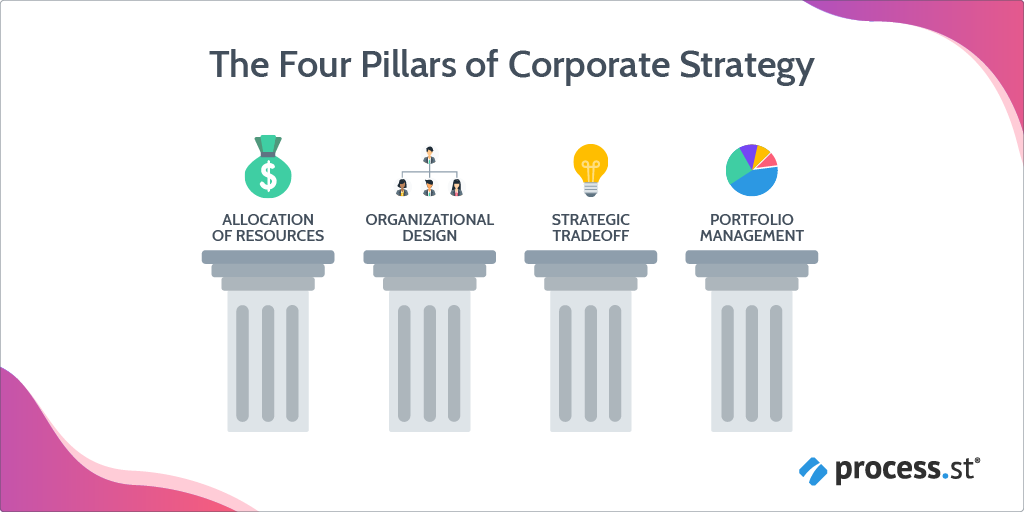
It was 1980 and the U.S. had crowned Donald Trump as a hero of business, turning real estate into gold. Trump had a net worth of $1.5 billion. However, a lack of corporate strategy was about to shake-up the Trump empire.
In 1988, Trump paid £365 million for the Eastern Air Shuttle. During the airline’s reign, its identity was passed from a no-fuss service to a one with maple-wood veneers and gold-plated features. A poorly strategized gamble that confused the brand’s identity. The lack of strategic direction meant Trump no longer held the Trump card, and his net worth plummeted along with the airline.
Worryingly, Trump’s failure to meet his organization’s objectives is a common occurrence in business, with only 2% of leaders stating they feel they will achieve 80-100% of their pre-set strategic objectives.
This is where Process Street comes to your aid.
This post will teach you what corporate strategy is, why it is important, and how you can implement an effective strategy for your business today – with access to our top free template resources. Check out our Strategic Planning Template below for a quick taster.
Click on the relevant subheader below to be directed to that section of this post. Alternatively, scroll down to read all about corporate strategy.
- What is corporate strategy?
- The benefits of corporate strategy
- Corporate strategy process
- Using Process Street to implement the corporate strategy process
What is corporate strategy?
Before the 1950s/60s, the term strategy was used in reference to war and politics, but never in business.
Post-war, many businesses began to build strategic planning functions.
Corporate strategy definition
Corporate strategy refers to the ideas and plans an organization has regarding its future. A corporate strategy will set the overall company direction by analyzing the corporation’s capabilities. With a corporate strategy, questions such as the following are asked:
- How do the various businesses of an organization fit together?
- How do the various businesses of an organization impact each other?
- How is the parent company structured, and how does this structure optimize human capital, processes, and governance?
My previous post, Hoshin Kanri: Gain a Competitive Advantage With This Lean Management Approach (Free Template), gives a good example of how strategy began to claw its way into the business realm. In this instance, the strategic planning model, Hoshin Kanri, was developed in Japan, a model originating from Samurai warfare ⚔️.
Strategy used in war was critical like corporate strategy is important in business. That is, poor strategy in both can result in catastrophic failure.
To illustrate this point, I want to take you back to 19th century America.
What is corporate strategy? Strategy in war, Custer’s last stand

General George Armstrong Custer was a renowned civil war hero, praised for his bravery and good fortune, however, I am going to let you in on a little secret…
Custer’s luck was about to run out!
Having poor strategic direction would lead Custer and his army to demise during the Battle of Little Bighorn in 1876. It is an infamous historical event, driven by impetuous decision making that catapulted the US army into a death trap.
So, what exactly happened?
Since 1840, American settlements had been expanding and seizing land from American Indian tribal groups, causing ongoing conflict.
On the 25th of June, 1876, Custer sat atop of his horse overlooking the banks of the Little Bighorn River in present-day Montana. It was here that Custer saw the largest Indian encampment ever to assemble on the plains. This camp is now known to have been led by chief Sitting Bulls.
Fearing he would be discovered and the camp settlers would escape, Custer jumped hastily into battle. This was strategic error #1.
Custer decided to divide his army into two battalions. Battalion 1 led by himself, and battalion 2 to be led by a soldier named Moreno. With 300 soldiers vs 3000 on the American Indian’s side, Custer was severely outnumbered. Never-the-less, he chose not to wait for further assistance. This was strategic error #2.
Moreno and his battalion were ordered to attack the camp by the Little Bighorn river whilst Custer waited at a high vantage point. As Moreno’s battalion approached, the number of mounted American Indian warriors began to increase. Due to little pre-planning, Moreno could only assume that Custer’s battalion would be joining in support. This was not the case as Custer remained on high ground.
With no support from Custer, Moreno was outnumbered and forced to retreat across the Bighorn River. The impacts of a lack of foreseen strategic planning began to cascade in severity. In the confusion, a rear-guard defense had not been planned, and so Moreno’s battalion was attacked from behind during their retreat.
Custer was observing the situation and to help, decided to attack the village from the opposite end. Unfortunately, it was too late.
The increasing numbers and the intensive attack from the American Indians forced Custer’s battalion to also retreat.
Slowly Custer’s army was surrounded. The remaining few formed a defensive circle, using horses’ bodies as a shielding wall. However, this wasn’t enough to withstand the brute force of the American Indian army. Custer and his army were defeated, losing 280 soldiers compared to 160 on the American Indian side.
To summarize, Custer’s strategic errors in this scenario were:
- Inflexibility and stubbornness ♀️: Custer’s innate stubbornness and inflexibility meant he didn’t use all of the resources available to him (aka backup from other battalions). In business, good strategy means to be adaptable, to accommodate market transformations, technological advancement, and to keep ahead of the changing business landscape. In addition to assessing and implementing feasible resources that will maximize corporate value and minimize waste.
- Impetuous decision making and a lack of planning : Jumping into battle before a feasible strategy was devised led to mass confusion, costing Custer and his army their lives. Investing time to account for alternative scenarios and the risks associated is as important in business.
What is corporate strategy? Business war and the Hungry Games – The Battle of the 2 Burgers

Fighting in business is more subtle than popping gun powder and cracking muskets. I watched a documentary titled the Battle of the Burgers a few months back. This documentary effectively illustrated business as tooth and claw combat via detailing Burger King’s and McDonald’s sizzling rivalry.
After watching, I wanted to do my research, so I devised the Hungry Games – The Battle of the 2 Burgers. 2 fast-food giants, which one wins the business battle?
3,
2,
1…let the games begin!
Round #1 : Total revenue
Coming into the first match, McDonald’s grabs the prize for financial success. In 2019, McDonald’s total revenue was $21.09 billion. This juicy number throws Burger Kings $1.78 billion to the maggots.
Round winner = McDonald’s.
Round #2 : Social media following
McDonald’s cooks up a strong social media following, with its Twitter account flaunting more than 2x as many followers compared to Burger King. In addition, McDonald’s Facebook account has ~10x more likes compared to Burger King’s Facebook page.
Round winner = McDonald’s.
Round #3 : Branding
Round #3 looks at how McDonald’s and Burger King brand themselves. If you look at what they post on social media, it is noticeable that Burger King places more emphasis on the food that they produce. In contrast, McDonald’s places more emphasis on displaying a happy culture.
You don’t need to go any further than their branding campaign to notice this difference.
- McDonald’s: I’m Lovin’ It – this slogan inspires happiness and fun. Two emotions the corporation wants to be associated with its brand.
- Burger King: Be Your Way – this slogan focusses on making the food individualistic and flexible to meet the customer’s specific taste.
So which style of branding wins?
I guess this one is up to debate. To be crowned winner relies on subjective opinion. Do you like the simplicity of good food adapted to how you like it? Or do you want to eat in a place that promotes fun and happiness in its culture?
Round winner = Subjective
Round #4 : Website
Back to the numbers, we turn our attention to the websites of these 2 fast-food chains. For assessment, we will use Hubspot’s award-winning website marketing grader tool. With this tool, all website-associated marketing is analyzed providing an overall grade on a scale of 1-100.
Doing this for both McDonald’s and Burger King’s websites, we obtain the following results:
- McDonald’s: Score = 58
- Burger King: Score = 77
Round winner = Burger King
That’s it for the battle of the burger brands, so who takes the podium?
Drum roll, please…
Winner : McDonald’s
McDonald’s corporate strategy seems to be working well, although Burger King’s strategizing has sliced a good chunk from McDonald’s market share. With a higher-value website, will the results flip in favor of Burger King in years to come? Get your spatulas ready, who do you think will be the next Hungry Games winner?
In the past, strategy was used primarily in warfare, cleaving the difference between success and failure. Today, strategy is mainly used as a reference in business. Despite this shift in perspective, the consequences of poor strategy remain the same… defeat.
The benefits of corporate strategy

A Good strategy can bridge the difference between success and failure. However, what about the more subtle benefits?
A Good corporate strategy maintains correct direction and alignment
Firstly, the benefits of having a well defined corporate strategy increase as the organization scales. Although smaller companies may be able to just about get away with not defining strategic direction – although this isn’t advised – larger organizations can’t. Effort is required to maintain the correct direction and alignment of operations.
To stay on track, a corporate strategy must remain flexible and adaptable towards any roadblocks or errors that may come the organization’s way.
Good corporate strategy creates wealth
When devising your strategy, it is a good idea to look into diversification, as this can bring benefits under the umbrella term corporate strategy. For instance, joint ventures bring in alternative revenue streams. However, when involved in strategic diversification, it is important to weigh up the costs against the actual return.
Diversification includes entry into new markets, new products/product lines, and new services – all of which demand substantially different skills. To ensure the most value is obtained via corporate strategic diversification, an adaptive and flexible approach must be maintained. Consider the following two questions:
- What businesses should the corporation be involved in?
- How will the corporate office manage the array of business units?
Good corporate strategy can increase market share
A good corporate strategy that is diverse will increase market share by introducing new products, exploring new regions, or targeting new groups of customers.
However, diversification can expose an organization to new risks, increase the number of non-profitable activities, and can constrain the conglomerates reducing flexibility. It must be warned that diversification needs to be adequately planned for, as to truly grasp the benefits and avoid potential risks, a thorough corporate strategic plan is needed.
Good corporate strategy helps manage change
“It must be considered that there is nothing more difficult to carry out, nor more doubtful of success, nor more dangerous to handle, than to initiate a new order of things” – Niccolò Machiavelli, The Prince
Change is a given for business, and the need to respond effectively to change is set to grow with our increasingly turbulent environment, economic, and cultural forces.
To manage change, managers have to confront basic questions, such as:
- What business(es) should we be in?
- How should we be organized to accomplish our strategy?
- What kinds of people do we need, and how will they be acquired, developed, and rewarded?
These are the types of questions covered whilst establishing the corporate strategy.
To help you manage change in your organization, read: 8 Critical Change Management Models to Evolve and Survive.
Good corporate strategy can mitigate against risk
Business decisions almost always bring with them an element of risk. A Corporate strategy will help manage this risk by analyzing the decisions made and contemplate possible future scenarios for each decision. To help you manage risk for your business, why not incorporate Process Street’s Risk Management Process in your strategy.
Click here to access Process Street’s Risk Management Process!
Corporate strategy process
In this next section, you will learn the corporate strategy implementation process, a process you can easily implement and execute for your business. Before that though, it is important to understand how corporate strategy fits in regarding the different strategic business levels.
Business-level strategy vs corporate level strategy
The business-level strategy has a customer focus, looking at how value can be provided to the customer. It is about meeting the needs of the customers and increasing operating profits.
Corporate-level strategy, on the other hand, looks at success from a higher level. Corporate strategy is focused on obtaining a mix of business units that allow the organization to succeed as a whole.
To explain further, the complete organizational strategy is divided into three distinct levels. These levels are separated based on the concerns and goals of the three hierarchical elements that make up an organization – at the corporate level, the business level, and at the functional level.
- The corporate strategic level: This is the top-level decision making that will determine how every hierarchical level of the organization operates.
- The business strategic level: This level takes the corporate-level strategic goals, and breaks down these goals so they are fine-grained and practical, based on business-level knowledge and experience.
- The functional level: The strategies and goals from the business and corporate level are turned into meaningful and measurable activities, such as specific projects and departmental objectives.
The level of focus for this article is corporate strategy.
The 4 pillars of corporate strategy
Although corporate strategy as a discipline is broad, there are several important components in need of focus. These components, as given by the Corporate Finance Institute, are as follows:
- The allocation of resources
- Organization design
- Portfolio management
- Strategic tradeoffs

Corporate strategic pillar #1: The allocation of resources
By resources, we are referring to 2 resources – people and capital. We want to maximize the capital of the entire firm and so leaders must determine how to allocate these resources to the various businesses or business units. This allocation can be thought of as a play-off, to devise the best combination for organizational success. Breaking down the factors related to the allocation of resources, we have:
People
- Consider leader and employee skills, and distribute them to the places that they are needed most and can deliver the most value.
- Ensure the appropriate talent is supplied and available to all businesses.
Capital
- Capital should be allocated so that it gives the highest risk-adjusted return.
- External operations should be analyzed (mergers and acquisitions) to allocate capital appropriately.
Corporate strategic pillar #2: Organizational design
The organizational design should be adapted to ensure the firm has the structure necessary and the related systems in place to maximize the value created. Factors to be considered include the role of the corporate office – is a centralized or decentralized approach taken? The reporting structure of the individuals and business units – is the structure vertical hierarchy, matrix reporting, etc?
Key factors related to the organization’s structure are:
Head office (centralized vs decentralized)
- Determine how much autonomy to give each business unit.
- Decide whether the decisions made are top-down or bottom-up.
- Think about the strategic influence of each business unit.
Organizational structure (reporting)
- Determine how large initiatives and commitments will be divided into smaller projects.
- Integrate business units and business functions such that there are no redundancies.
- Balance risk and return by separating responsibilities.
- Develop centers of excellence.
- Determine the appropriate delegation of authority.
- Set governance structures.
- Set reporting structures (military/top-down, matric reporting).
Corporate strategy, pillar #3: Portfolio management
Portfolio management looks at the different business units with the question: How does each business unit support/work with the other/s? The management of an organization’s portfolio is referred to as portfolio management, and portfolio management decides how the organization plays.
Thinking about portfolio management with corporate strategy in mind, you must:
- Decide what business to operate in.
- Determine the extent of vertical integration your firm should have.
- Manage risk via diversification and reduce the correlation of results across businesses.
- Create strategic options via seeding new opportunities that could be invested in heavily.
- Make sure your portfolio is well-balanced about market trends via monitoring the competitive landscape.
Corporate strategy, pillar #4: Strategic tradeoffs ⚖
A challenging aspect of corporate strategy is attempting to balance the tradeoffs between risk and return. As already mentioned, with most business decisions a degree of risk is incurred. If a holistic view is taken, however, an optimal level of risk vs return is pursued.
The main factors to consider when thinking about strategic trade-off are:
Risk management
- Firm-wide risk is dependent on the strategies the organization chooses to implement.
- Product differentiation is a high-risk strategy and can result in a market leadership breakdown.
- Copycat strategies should be considered, i.e. looking at what other companies have done and modifying this strategy slightly.
- It’s important to be aware of the strategies and the risks associated across a given firm.
- Some areas might require true differentiation – or cost leadership – but other areas might be better suited for copycat strategies.
- Business unit autonomy must be considered as this is important when managing business risk.
Generating returns
- Strategies that impose high risk, are often associated with higher returns.
- It is important to have an appropriate number of options in your portfolio.
Incentives
- Incentive structure plays a big role in how much risk and return is sought by managers.
- Separated risk management and risk generation will mean both are pursued to the desired level as separate entities.
- Manage overlapping timelines with risks and returns ranging from short-term/long-term, keep dispersion as appropriate.
The corporate strategy process
Corporate strategy is formulated by top managers. Responsibility is then passed down through the organization via the different departments. The entire set of activities is referred to as the strategizing process. I have summarized this process as follows:
- Step 1: The vision and mission statements are given. The mission statement lays out the organization’s purpose of being whereas the vision statement states based on that purpose, this is what we want to become. The vision statement is a future-orientated declaration and corporate strategy will flow directly from this statement.
- Step 2: Organizational values are set and shared within the organization.
- Step 3: The corporate strategy is then formulated into a strategic plan. The plan should allow for the achievement of the organization’s mission.
Strategic planning, together with organizing, leading, and controlling are sometimes referred to as P-O-L-C. At Process Street we have top free template resources you can jump in and use today to help you formulate your corporate strategy via the P-O-L-C process. I have detailed these templates below, along with a whistle-stop tour on how you can get started with Process Street.
Using Process Street to implement the corporate strategy process
Process Street is superpowered checklists.
With Process Street you can document, manage, and control any process. In this article, we are primarily focused on your corporate strategic procedures. The templates listed below have been selected from our extensive template library, to help you excogitate and execute an effective strategic planning process.
Plan: Strategic Planning Template
Run this checklist to plan, define, and document your business strategy. Adopt a flexible and inclusive approach by implementing the Cascade Strategic Planning Model.
Click here to access our Strategic Planning Template!
Key checklist feature: Our approvals feature is used to ensure your strategic plan is adequately assessed by senior levels before implementation.
Organize: Work breakdown Structure Template
Breakdown your work/project into manageable chunks, and organize tasks between your team with our Work Breakdown Structure Template.
Click here to access our Work Breakdown Structure Template!
Key checklist feature: This checklist is designed to be edited to suit your specific needs. You are invited to make use of Process Street’s automation features such as:
- Stop tasks – To ensure task order, ✋
- Conditional logic – To adapt your checklist to suit your specific needs,
- Dynamic due dates – To ensure no deadline is missed, ⏱
- Task permissions – To hide specific tasks from different users to make you checklists more private.
- Task assignments – So you can assign users and groups to individual tasks in your checklists, making it easy to see who is responsible for what.
- Role assignments – Pre-assign tasks to different roles on your team.
- Embed widget – So you can view and interact with other apps and content in your processes.
- Webhooks – Send automated messages or information directly to other apps.
- Approvals – Streamline any process that needs authorization by another person. ✅
- And more!
Leading: Project Management Process
Successful management and smooth completion of projects are key for good leadership. Have your leadership teams use our Project Management Process checklist to manage and complete each project in their pipeline, to meet all strategic objectives.
Click here to access our Project Management Process!
Key checklist feature: Dynamic due dates to ensure that your leadership teams are notified of important due dates for a given project. This keeps tasks, processes, and projects running smoothly and in line with given timelines.
Controlling: Risk Management Process
Run our Risk Management Process checklist for full control over your operations and the risks involved.
Click here to access our Risk Management Process checklist!
Key checklist feature: Stop tasks to ensure all essential tasks are completed. When controlling risk, it is important to avoid error, as slip-ups can leave your organization vulnerable to the very risks you are trying to control/mitigate.
You can use Process Street to create a checklist for any process. Whether this is for strategic planning, strategic leadership, strategic organization, or strategic control.
For more information on how you can create and edit checklists using Process Street, watch the below video: Basics of Creating and Editing Templates.
Be crowned business war heroes by using Process Street to implement corporate strategy
Good corporate strategy can propel an organization to success. Without it, you are going into business blind.
The consequences of poor strategic planning can be fatal to an organization. But by taking the time to implement a correct strategic planning process, utilizing Process Street and our free template resources, you are giving your organization a fighting advantage in the business arena.
How do you devise and implement an effective corporate strategy in your business or line of work? Do you have set processes and procedures to help you? Do you use pre-define strategic planning models? Please comment below as we would love to hear from you. Who knows, you may even get featured in an upcoming article!







Jane Courtnell
Hi there, I am a Junior Content Writer at Process Street. I graduated in Biology, specializing in Environmental Science at Imperial College London. During my degree, I developed an enthusiasm for writing to communicate environmental issues. I continued my studies at Imperial College's Business School, and with this, my writing progressed looking at sustainability in a business sense. When I am not writing I enjoy being in the mountains, running and rock climbing. Follow me at @JaneCourtnell.